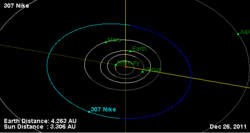Astronomy:307 Nike
From HandWiki
Short description: Main-belt asteroid
 Orbital diagram | |
| Discovery | |
|---|---|
| Discovered by | Auguste Charlois |
| Discovery site | Nice |
| Discovery date | 5 March 1891 |
| Designations | |
| (307) Nike | |
| Pronunciation | /ˈnaɪkiː/[1] |
| Named after | Nike |
| A891 EB; 1957 LM | |
| Minor planet category | Main belt |
| Orbital characteristics[2] | |
| Epoch 31 July 2016 (JD 2457600.5) | |
| Uncertainty parameter 0 | |
| Observation arc | 125.12 yr (45699 d) |
| |{{{apsis}}}|helion}} | 3.3226 astronomical unit|AU (497.05 Gm) |
| |{{{apsis}}}|helion}} | 2.4899 AU (372.48 Gm) |
| 2.9063 AU (434.78 Gm) | |
| Eccentricity | 0.14327 |
| Orbital period | 4.95 yr (1809.7 d) |
| Mean anomaly | 170.550° |
| Mean motion | 0° 11m 56.148s / day |
| Inclination | 6.1260° |
| Longitude of ascending node | 100.966° |
| 324.764° | |
| Physical characteristics | |
| Dimensions | 54.96±3.3 km |
| Rotation period | 7.902 h (0.3293 d)[2] 7.902 ± 0.005 h[3] |
| Geometric albedo | 0.0524±0.007 |
| C | |
| Absolute magnitude (H) | 10.12 |
Nike (minor planet designation: 307 Nike) is a sizeable asteroid of the asteroid belt. It was discovered by Auguste Charlois on 5 March 1891 while working at the Nice Observatory. Charlois named it after the Greek goddess of victory, as well as the Greek name for the city where it was discovered.[4] Measurement of the light curve of this asteroid in 2000 indicates a rotation period of 7.902 ± 0.005 hours.[3]
On 2 December 1972, Pioneer 10 made one of its nearest passages of an asteroid when it passed 307 Nike at a distance of about 8.8 million kilometers (0.059 AU) during the spacecraft's pioneering trip through the asteroid belt. No data was collected.[5]
References
- ↑ "Nike". Nike. Oxford University Press. http://www.lexico.com/definition/Nike.
- ↑ 2.0 2.1 "307 Nike". JPL Small-Body Database. NASA/Jet Propulsion Laboratory. https://ssd.jpl.nasa.gov/sbdb.cgi?sstr=307;cad=1.
- ↑ 3.0 3.1 Lazar, S.; Lazar, P., III; Cooney, W.; Wefel, K. (June 2001). "Lightcurves and Rotation Periods for Minor Planets (305) Gordonia (307) Nike, (337) Devosa, and (352) Gisela". The Minor Planet Bulletin 28: 32–34. Bibcode: 2001MPBu...28...32L.
- ↑ Schmadel, Lutz D. (2003). Dictionary of minor planet names. Physics and astronomy online library. 1 (5th ed.). Springer. p. 41. ISBN 3-540-00238-3. https://books.google.com/books?id=KWrB1jPCa8AC&pg=PA41.
- ↑ Fimmel, Richard O.; van Allen, James; Burgess, Eric (1980). Pioneer: first to Jupiter, Saturn, and beyond. Washington D.C., USA: NASA Scientific and Technical Information Office. https://books.google.com/books?id=sOzpfV4ed-8C.
External links
- 307 Nike at AstDyS-2, Asteroids—Dynamic Site
- 307 Nike at the JPL Small-Body Database
 |

